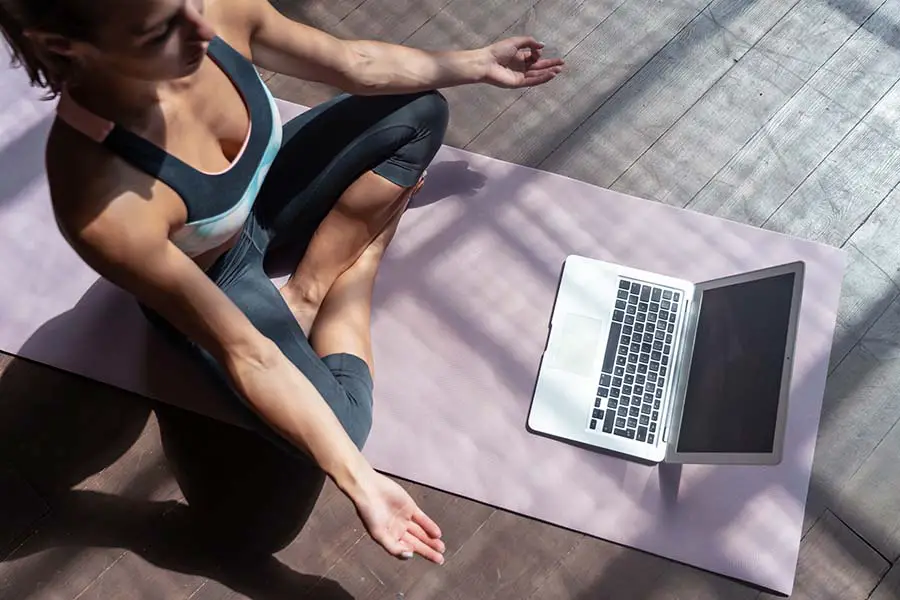How much do yoga instructors make? What is the average yoga teacher salary? If you’re asking these questions, you’re probably attempting to figure out whether or not to be a yoga instructor in the near future.
Even though the concept of teaching yoga to others is appealing, you may or may not have heard of other instructors who are trying to make ends meet.
This article will go beyond the basics to offer you a closer look at the market and what might affect your earnings. Keep reading!
How Much Do Yoga Instructors Make?
The typical wage of a qualified instructor appears to be a source of considerable misunderstanding. Fitness centers compensate instructors in various ways, which vary from one to the next.
Yoga instructors in the United States earn an average of $24.96 to $31.11 per hour, with a national average compensation of $30,000 to $100,000 per year.

How Do Fitness Centers Pay Their Yoga Teacher Salary? – 3 Common Methods
Whether you intend to be a beginner instructor or a yoga studio owner, you must understand how yoga studios compensate their instructors.
We will go through the top three payment options used by some studios to compensate teachers, as well as the pros and cons of each way.
Hourly Wage Or Flat-Rate Wage Per Class
Definition
The most common way to pay a yoga instructor is by the hour or the class. The average teacher’s salary might vary depending on the fitness center.
The amount can be based on how skilled you are or the number of minutes you spend in class. If the owner expects you to work exclusively for them, you will be able to negotiate larger hourly rates.
You might also be wondering, “How much do yoga teachers make per class?”. Instead of an hourly wage, there are still some yoga studios that pay their instructors for the classes they teach each week. That yoga teacher salary is called a flat-rate per class wage.
However, if you’re just affiliated with one fitness club, you won’t be able to supplement your earnings until you teach private lessons.
Pros And Cons
With hourly wage or flat-rate per class wage, you will know ahead of time how much you can earn when you are teaching. If you agree to terms for $50 for each class, you will earn $500 per week if you teach 10 lessons. If you’re paid hourly, you need to figure out how many hours you did that week to get paid.
For fitness club owners, the fixed-wage simplifies billing and clarifies all financial obligations before the instructor even begins teaching classes.
Yoga establishments are also known to pay teachers by the minutes. The proprietors will compute how many minutes a teacher spent instructing, starting from the moment they enter the classroom.
Many teachers prefer to be paid by the hour since certain lessons may last longer than expected, allowing them to bill the studio owners properly. If the length of your classes varies, the per-hour wage approach is the way to go.
Based On The Number Of Students In Classes

Definition
This way is determined by the number of students who attend the class. This approach is comparable to owning a yoga studio in that you can only make money if a certain number of students turn up.
After all, the studios are a company that has to make money to stay afloat. Some teachers can help the yoga studio earn more money, and they are compensated accordingly.
Instructors charge between $1 and $3 per student on average.
The instructor will earn $30-90 per session if there are about 30 people in that class, depending on how much the yoga studio pays.
All teachers have the same pay rate at the yoga studios. The only variable is the number of students. You will make more money if you have 20 students per class than if you just have 10.
Pros And Cons
The pro is that you’re encouraged to become more friendly and outgoing to attract more students to your session. On the other hand, if you don’t bring in enough students, you won’t get paid.
And this type of rivalry can produce a toxic environment between instructors in the same studio. To thrive with this paying method, you’ll need a large network or good sales abilities.
This method requires studio owners to be more action-oriented engage with their instructors throughout the process. They must come to each class to count the students, and the payment methodology is distinctive. Alternatively, they may utilize software to take attendance automatically.
The major problem with paying based on the number of students is that attendance fluctuates depending on the time of day. Usually, more students show up in the early morning rather than in the evening.
This difference indicates that even if two yoga instructors are equally skilled, the instructor who works in the mornings will earn more than the instructor who works in the evenings.
As a result of this distinction, certain teachers have greater flexibility regarding the periods and times they may work.
Flat-Rate Wage With Student Bonuses
Definition
This paying method combines the flat-rate wage with extra bonuses if attendance meets the yoga studio’s minimal requirement. For example, the instructor is promised $60 per session plus an additional $25 for every 10 students they bring in above a certain number.

Pros And Cons
This method is the best since it ensures that all teachers are paid and the best-performing instructors are compensated more. It lowers instructor jealousy and competition, allowing the most passionate instructors to advance to the top.
Using this method can encourage instructors to work harder because they are assured of basic pay and may earn extra money by attracting more students.
You will always be aware that you’ll be paid a base wage, which will encourage you to recruit additional students. On the plus side, you won’t have to worry about bringing in more students to meet the target.
The disadvantage of this payout arrangement is that some fitness centers can impose a maximum attendance bonus cap. Even if a teacher can bring many students to the class, they still can not make ends meet.
How To Become A Yoga Instructor
After finding out how much does a yoga instructor make, you might want to become a certified teacher now. However, it may appear to be a tricky task.
We will go over everything you need to know about working as a yoga instructor and earning more than minimum wage.

Step 1: Decide Your Yoga Style
There are various kinds of yoga, for example, Bikram, Vinyasa, Hatha, Sivananda Ashtanga, etc.
It’s crucial to figure out what style appeals to you and whether the demography for the location you want to teach is a suitable match for the style you want to teach.
Step 2: Learn And Be Professional At All Yoga Stances
In order to become a professional instructor, the most important thing you need to do is, of course, to learn yoga. You should have a strong grasp of the yoga practice on an individual basis before you begin your path to becoming a yoga instructor.
Nowadays, you may enroll in a yogi school that teaches a wide range of yoga methods. There are many various forms of yoga, and taking courses in each of them will help you figure out which style best suits your specific tastes.
This may sound self-evident, but the more you improve your skills, the better you will be able to teach. The more invested you are in the material, the more genuine and important your participation in the class will be.
Step 3: Register With Yoga Alliance
To become a yoga teacher, you need to complete the Yoga Alliance’s minimal criteria of yoga practice. It is an internationally recognized certification for yoga teachers.
Step 4: Apply For A RYT Certification
After you have the Yoga Alliance’s certification, it doesn’t guarantee that you practice yoga, have enough teaching experience, or that your training course was of excellent standard. That’s why you need to apply for an RYT (Registered Yoga Teacher) credential.
To obtain your RYT certification, you must finish a 200-hour yoga training program and pay a $50 registration fee as well as your yearly dues of $65.
Although some studios do not require this certification, possessing one will provide you with a wider range of prospects as well as other advantages.
Step 5: Do Research About Your Upcoming Workplace
Some yoga instructors customize their lessons to certain demographics, while others teach in specific places.
An instructor, for example, could elect to target a specific audience, such as delivering yoga training to elite athletes, or they might choose to teach lessons at a yoga class or online.
If you prefer to teach at a yoga studio, then you should speak up about your work opportunities in the interview. Besides the basic things about the job like working hours and paying methods, you should ask for additional payment for conducting administration, marketing, or retail jobs.
Small yoga studios might pay about $30 for each class, while bigger studios can pay up to $50 – 60 per class. And for every extra 10 students, you may earn an additional $1-3 per each. If you have a fair amount of experience, your compensation per class might reach $70 – 80 or more.
Step 6: Teach Private Yoga Lesson Or Online Training Class

If you want to teach private yoga lessons instead, you should look into local personal trainer fees. Both of your rates should be comparable. Since you can set your own prices, it’s also a way to boost your salary.
If your students want you to travel to their houses or different locations, you might charge more. Consider offering private yoga packages rather than individual classes to increase your instructor pay. This provides you with a financial edge and encourages your students to continue their yoga classes.
Since the virus-related lockdowns, online yoga training has become more popular. Consider launching your own online session if you can create a high-quality series of courses.
Step 7: Do Email Marketing For Your Yoga Class
If you want to start opening your own class, you need to do email marketing. The best way is to create a mailing list. It helps you stay in contact with the folks who attend your classes and attract more potential customers.
In detail, it will assist in keeping you updated so that when your connection requires a yoga instructor, they will know who to contact.
This method is more vital than other marketing strategies. Moreover, it doesn’t require much money and professional skills to implement like other marketing methods.
Conclusion
Today, yoga can be found practically everywhere. The purpose of this article is to provide you with information on how much do yoga instructors make. If you want to boost your yoga instructor salary, you will need to work harder, invest in yourself and create a strong community. Don’t forget to maintain your certification and skills to make a hefty sum of money!









0 Comments